Predicting Winter Ammonia and Methane Emissions from a Naturally Ventilated Dairy Barn in a Cold Region Using an Adaptive Neural Fuzzy Inference System
Abstract
1. Introduction
2. Materials and Methods
2.1. Targeted Barn and Measurement Points
2.2. Ventilation Rate and Emission Rate
2.3. Preprocessing of Data
2.4. ANFIS Model
2.5. Model Evaluation
3. Results
3.1. Monthly and Daily Emissions
3.1.1. NH3 Emissions
3.1.2. CH4 Emissions
3.2. Pearson Correlation Coefficients
3.3. Prediction Model
3.3.1. Prediction Model of NH3 Emissions
3.3.2. Prediction Model of CH4 Emissions
3.4. Comparison of Different Prediction Models
4. Discussion
- (1)
- The rationale for limiting the present study to wintertime, naturally ventilated dairy barns stems from the unique “natural experimental window” provided by this season: in cold regions, tightly shut windows and doors curtail ventilation to conserve heat, allowing NH3 and CH4 to accumulate rapidly under high stocking densities. This amplifies emission signals and facilitates the accurate identification of key driving factors. Moreover, the relatively stable external meteorological conditions in winter allow the emission baseline to be primarily attributed to indoor variables, thereby minimizing meteorological noise. Future work will extend the scope to mechanically ventilated barns and incorporate continuous measurements across spring, summer, autumn, and multiple years. Under tighter control of meteorological variability, a year-round NH3 and CH4 emission model that is both universally applicable and stable in the long-term will be systematically developed and validated.
- (2)
- This study employs ANFIS to predict and model gas emissions; however, the membership functions are determined predominantly through empirical means and lack explicit physical meaning. When the model is extrapolated to environmental conditions outside the calibration range (e.g., high summer temperatures), its optimal functional form may lose validity. Future work will incorporate an adaptive function selection framework grounded in information theoretic criteria, replacing manual trial-and-error with data-driven optimization to reduce subjective bias. Concurrently, systematic long-term monitoring across seasons and climate zones will be undertaken to build a comprehensive function–environment mapping repository, enhancing model robustness under diverse environmental conditions.
- (3)
- There are limitations in monitoring environmental factors, and although a variety of environmental factors were measured, they did not cover all potential influences. Future studies could introduce more environmental variables and dairy barn management factors to more fully characterize the relationship between the dairy barn environment and gas emissions.
5. Conclusions
Author Contributions
Funding
Institutional Review Board Statement
Data Availability Statement
Conflicts of Interest
References
- Rodrigues, A.R.; Silva, M.E.; Silva, V.F.; Maia, M.R.; Cabrita, A.R.; Trindade, H.; Fonseca, A.J.; Pereira, J.L. Implications of seasonal and daily variation on methane and ammonia emissions from naturally ventilated dairy cattle barns in a Mediterranean climate: A two-year study. Sci. Total Environ. 2024, 946, 173734. [Google Scholar] [CrossRef] [PubMed]
- Petersen, S.O.; Ma, C.; Hilgert, J.E.; Mjöfors, K.; Sefeedpari, P.; Amon, B.; Aarnink, A.; Francó, B.; Dragoni, F.; Groenestein, K.; et al. In-vitro method and model to estimate methane emissions from liquid manure management on pig and dairy farms in four countries. J. Environ. Manag. 2024, 353, 120233. [Google Scholar] [CrossRef] [PubMed]
- Tabase, R.K.; Næss, G.; Larring, Y. Ammonia and methane emissions from small herd cattle buildings in a cold climate. Sci. Total Environ. 2023, 903, 166046. [Google Scholar] [CrossRef] [PubMed]
- Chen, J.; Chen, S.; Li, G.; Yang, C.; Peng, D.; Zhao, Y.; Han, L.; Wang, Z.; Gu, X. Thermal environment and air quality of in a typical barn of lactating low in Beijing area in spring. J. Domest. Anim. Ecol. 2017, 38, 45–50. [Google Scholar]
- Du, Y.; Wei, Y.; Li, Z.; Yang, H.; Li, H.; Liu, Y.; Liu, R. Analysis of ammonia prevention and control and milk yield in large-scale dairy farms in Xinjiang. Feed. Manag. 2024, 12, 55–61. [Google Scholar]
- Ngwabie, N.M.; Jeppsson, K.H.; Gustafsson, G.; Nimmermark, S. Effects of animal activity and air temperature on methane and ammonia emissions from a naturally ventilated building for dairy cows. Atmos. Environ. 2011, 45, 6760–6768. [Google Scholar] [CrossRef]
- Tedeschi, L.O.; Abdalla, A.L.; Álvarez, C.; Anuga, S.W.; Arango, J.; Beauchemin, K.A.; Becquet, P.; Berndt, A.; Burns, R.; De Camillis, C.; et al. Quantification of methane emitted by ruminants: A review of methods. J. Anim. Sci. 2022, 100, skac197. [Google Scholar] [CrossRef] [PubMed]
- Li, T.; Wang, C.; Ji, W.; Wang, Z.; Shen, W.; Feng, Y.; Zhou, M. Cutting-edge ammonia emissions monitoring technology for sustainable livestock and poultry breeding: A comprehensive review of the state of the art. J. Clean. Prod. 2023, 428, 139387. [Google Scholar] [CrossRef]
- Zhao, W.; Xu, L.; Wang, C.; Shi, Z. Greenhouse gas and ammonia emissions of naturally ventilated cowsheds with different floor types in winter. J. China Agric. Univ. 2020, 25, 142–151. [Google Scholar]
- Kammer, J.; Décuq, C.; Baisnée, D.; Ciuraru, R.; Lafouge, F.; Buysse, P.; Bsaibes, S.; Henderson, B.; Cristescu, S.M.; Benabdallah, R.; et al. Characterization of particulate and gaseous pollutants from a French dairy and sheep farm. Sci. Total Environ. 2020, 712, 135598. [Google Scholar] [CrossRef] [PubMed]
- Tabase, R.K.; Millet, S.; Brusselman, E.; Ampe, B.; De Cuyper, C.; Sonck, B.; Demeyer, P. Effect of ventilation control settings on ammonia and odour emissions from a pig rearing building. Biosyst. Eng. 2020, 192, 215–231. [Google Scholar] [CrossRef]
- Shi, Z.; Sun, X.; Lu, Y.; Xi, L.; Zhao, X. Emissions of ammonia and hydrogen sulfide from typical dairy barns in central China and major factors influencing the emissions. Sci. Rep. 2019, 9, 13821. [Google Scholar] [CrossRef] [PubMed]
- Xie, Q.; Ni, J.Q.; Su, Z. A prediction model of ammonia emission from a fattening pig room based on the indoor concentration using adaptive neuro fuzzy inference system. J. Hazard. Mater. 2017, 325, 301–309. [Google Scholar] [CrossRef] [PubMed]
- Rychła, A.; Amon, B.; Hassouna, M.; van der Weerden, T.J.; Winiwarter, W. Costs and effects of measures to reduce ammonia emissions from dairy cattle and pig production: A comparison of country-specific estimations and model calculations. J. Environ. Manag. 2023, 344, 118678. [Google Scholar] [CrossRef] [PubMed]
- Ding, L.; Lv, Y.; Li, Q.; Wang, C.; Yu, L.; Zong, W. Prediction model of ammonia emission from chicken manure based on fusion of multiple environmental parameters. Trans. Chin. Soc. Agric. Mach. 2022, 53, 366–375. [Google Scholar]
- Xie, Q.; Ni, J.Q.; Li, E.; Bao, J.; Zheng, P. Sequential air pollution emission estimation using a hybrid deep learning model and health-related ventilation control in a pig building. J. Clean. Prod. 2022, 371, 133714. [Google Scholar] [CrossRef]
- Hempel, S.; Ouatahar, L.; Janke, D.; Doumbia, E.M.; Willink, D.; Amon, B.; Bannink, A.; Amon, T. Ammonia emission prediction for dairy cattle housing from reaction kinetic modeling to the barn scale. Comput. Electron. Agric. 2022, 199, 107168. [Google Scholar] [CrossRef]
- Liu, S.; Ni, J.Q. Identified factors and predicted unidentified-factors affecting ammonia emissions from a swine building. J. Hazard. Mater. 2023, 453, 131365. [Google Scholar] [CrossRef] [PubMed]
- Liu, H.; Tana; Zhen, Q.; Hurichabilige; Meng, X.; Li, W. Environ-economic assessment of the solar coupled heat pump heating system for dairy barns in severe cold region. Energy Build. 2025, 328, 115166. [Google Scholar] [CrossRef]
- Chao, L. Effects of Different Feeding Times on Daily Behavior of Lactating Cows. Master’s Thesis, Inner Mongolia Agricultural University, Hohhot, China, 2022. [Google Scholar] [CrossRef]
- CIGR. CIGR International Commission of Agricultural Engineering, Section II 4th Report of Working Group Climatization of Animal Houses Heat and Moisture Production; CIGR: Horsens, Denmark, 2002. [Google Scholar]
- Ogink, N.W.; Mosquera, J.; Calvet, S.; Zhang, G. Methods for measuring gas emissions from naturally ventilated livestock buildings: Developments over the last decade and perspectives for improvement. Biosyst. Eng. 2013, 116, 297–308. [Google Scholar] [CrossRef]
- Pedersen, S.; Blanes-Vidal, V.; Jørgensen, H.; Chwalibog, A.; Haeussermann, A.; Heetkamp, M.J.W.; Aarnink, A.J.A. Carbon dioxide production in animal houses: A literature review. Agric. Eng. Int. CIGR J. 2008, X. X, 1–9. [Google Scholar]
- Fan, B. Research on Dairy Farm Precision Management Based on Multiscale Environment Analysis. Ph.D. Thesis, Chinese Academy of Agricultural Sciences, Beijing, China, 2019. [Google Scholar]
- Yu, S.; Liu, Y.; Tang, Y.; Li, X.; Li, W.; Li, C.; Zhang, Y.; Lan, H. Non-destructive quality assessment method for Korla fragrant pears based on electrical properties and adaptive neural-fuzzy inference system. Comput. Electron. Agric. 2022, 203, 107492. [Google Scholar] [CrossRef]
- Ghenai, C.; Al-Mufti, O.A.A.; Al-Isawi, O.A.M.; Amirah, L.H.L.; Merabet, A. Short-term building electrical load forecasting using adaptive neuro-fuzzy inference system (ANFIS). J. Build. Eng. 2022, 52, 104323. [Google Scholar] [CrossRef]
- Qu, Q.; Groot, J.C.; Zhang, K.; Schulte, R.P. Effects of housing system, measurement methods and environmental factors on estimating ammonia and methane emission rates in dairy barns: A meta-analysis. Biosyst. Eng. 2021, 205, 64–75. [Google Scholar] [CrossRef]
- Sanchis, E.; Calvet, S.; Del Prado, A.; Estellés, F. A meta-analysis of environmental factor effects on ammonia emissions from dairy cattle houses. Biosyst. Eng. 2019, 178, 176–183. [Google Scholar] [CrossRef]
- Pedersen, J.; Feilberg, A.; Nyord, T. Effect of storage and field acidification on emissions of NH3, NMVOC, and odour from field applied slurry in winter conditions. J. Environ. Manag. 2022, 310, 114756. [Google Scholar] [CrossRef] [PubMed]
- Fangueiro, D.; Merino, P.; Pantelopoulos, A.; Pereira, J.L.; Amon, B.; Chadwick, D.R. The implications of animal manure management on ammonia and greenhouse gas emissions. In Technology for Environmentally Friendly Livestock Production; Springer: Cham, Switzerland, 2023; pp. 99–136. [Google Scholar]
- Hempel, S.; Saha, C.K.; Fiedler, M.; Berg, W.; Hansen, C.; Amon, B.; Amon, T. Non-linear temperature dependency of ammonia and methane emissions from a naturally ventilated dairy barn. Biosyst. Eng. 2016, 145, 10–21. [Google Scholar] [CrossRef]
- Huang, T.; Rong, L.; Zhang, G. Investigating the feasibility of using computational fluid dynamics based response surface methodology and neural network to model the performance of the individualised ventilation in sow houses. Biosyst. Eng. 2022, 214, 138–151. [Google Scholar] [CrossRef]
- Hesami, M.; Pepe, M.; Monthony, A.S.; Baiton, A.; Jones, A.M.P. Modeling and optimizing in vitro seed germination of industrial hemp (Cannabis sativa L.). Ind. Crops Prod. 2021, 170, 113753. [Google Scholar] [CrossRef]
- Schrade, S.; Zeyer, K.; Mohn, J.; Zähner, M. Effect of diets with different crude protein levels on ammonia and greenhouse gas emissions from a naturally ventilated dairy housing. Sci. Total Environ. 2023, 896, 165027. [Google Scholar] [CrossRef] [PubMed]
- Pereira, J.; Misselbrook, T.H.; Chadwick, D.R.; Coutinho, J.; Trindade, H. Ammonia emissions from naturally ventilated dairy cattle buildings and outdoor concrete yards in Portugal. Atmos. Environ. 2010, 44, 3413–3421. [Google Scholar] [CrossRef]
- D’Urso, P.R.; Arcidiacono, C.; Valenti, F.; Cascone, G. Assessing influence factors on daily ammonia and greenhouse gas concentrations from an open-sided cubicle barn in hot mediterranean climate. Animals 2021, 11, 1400. [Google Scholar] [CrossRef] [PubMed]
- Poteko, J.; Zähner, M.; Schrade, S. Effects of housing system, floor type and temperature on ammonia and methane emissions from dairy farming: A meta-analysis. Biosyst. Eng. 2019, 182, 16–28. [Google Scholar] [CrossRef]
- Huang, D.; Guo, H. Diurnal and seasonal variations of greenhouse gas emissions from a naturally ventilated dairy barn in a cold region. Atmos. Environ. 2018, 172, 74–82. [Google Scholar] [CrossRef]
- Vechi, N.T.; Mellqvist, J.; Scheutz, C. Quantification of methane emissions from cattle farms, using the tracer gas dispersion method. Agric. Ecosyst. Environ. 2022, 330, 107885. [Google Scholar] [CrossRef]
- Hayek, M.N.; Miller, S.M. Underestimates of methane from intensively raised animals could undermine goals of sustainable development. Environ. Res. Lett. 2021, 16, 063006. [Google Scholar] [CrossRef]

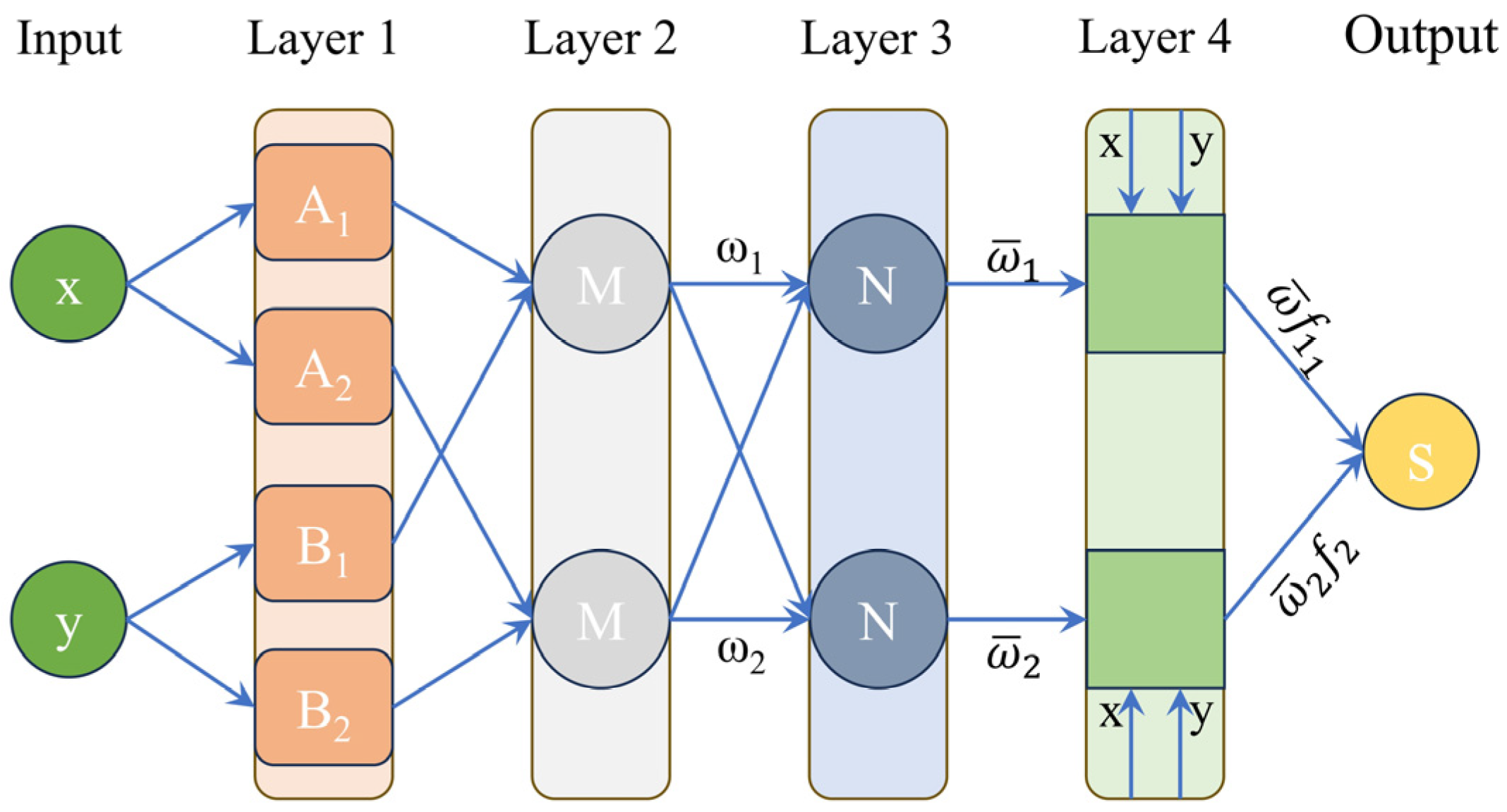
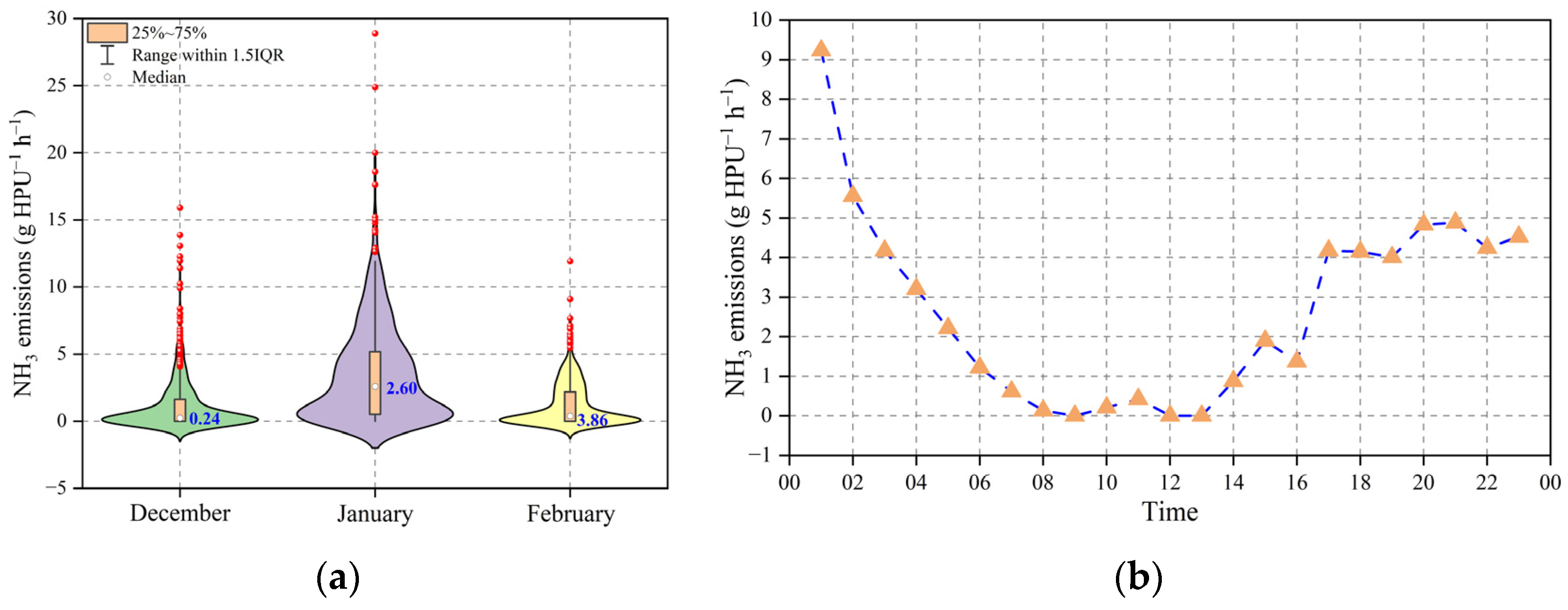
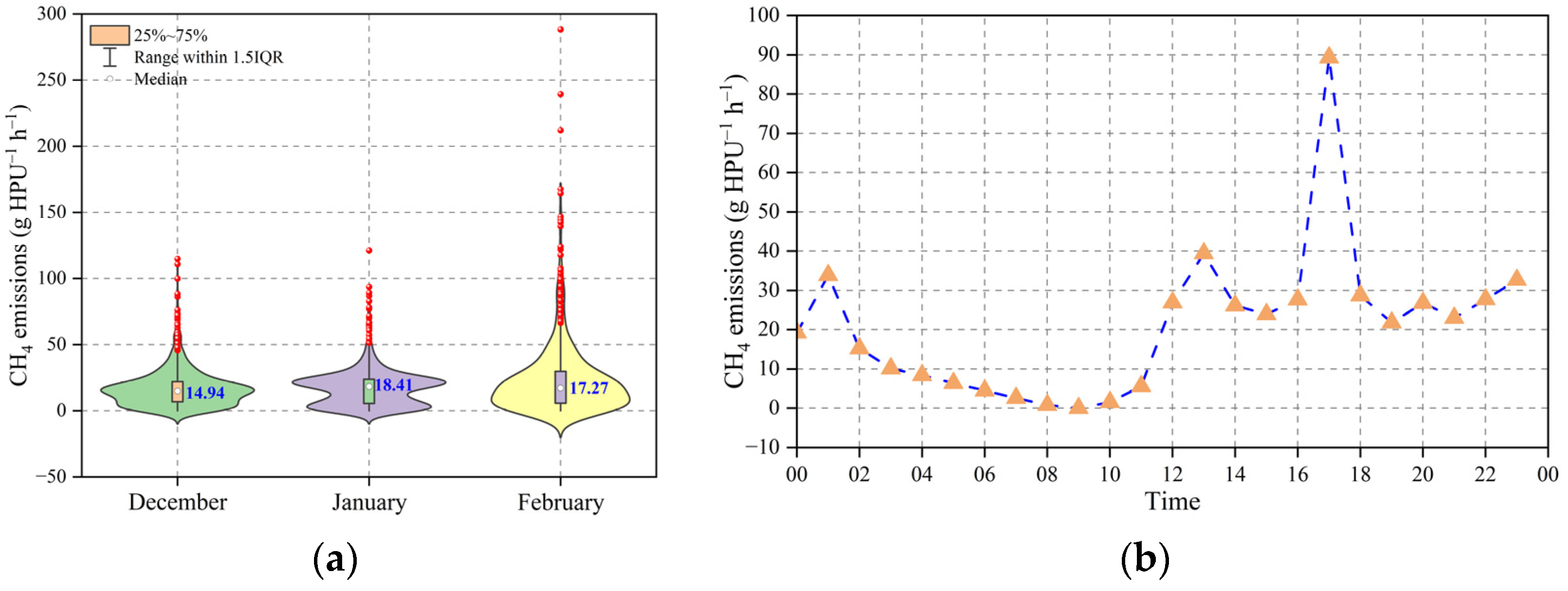
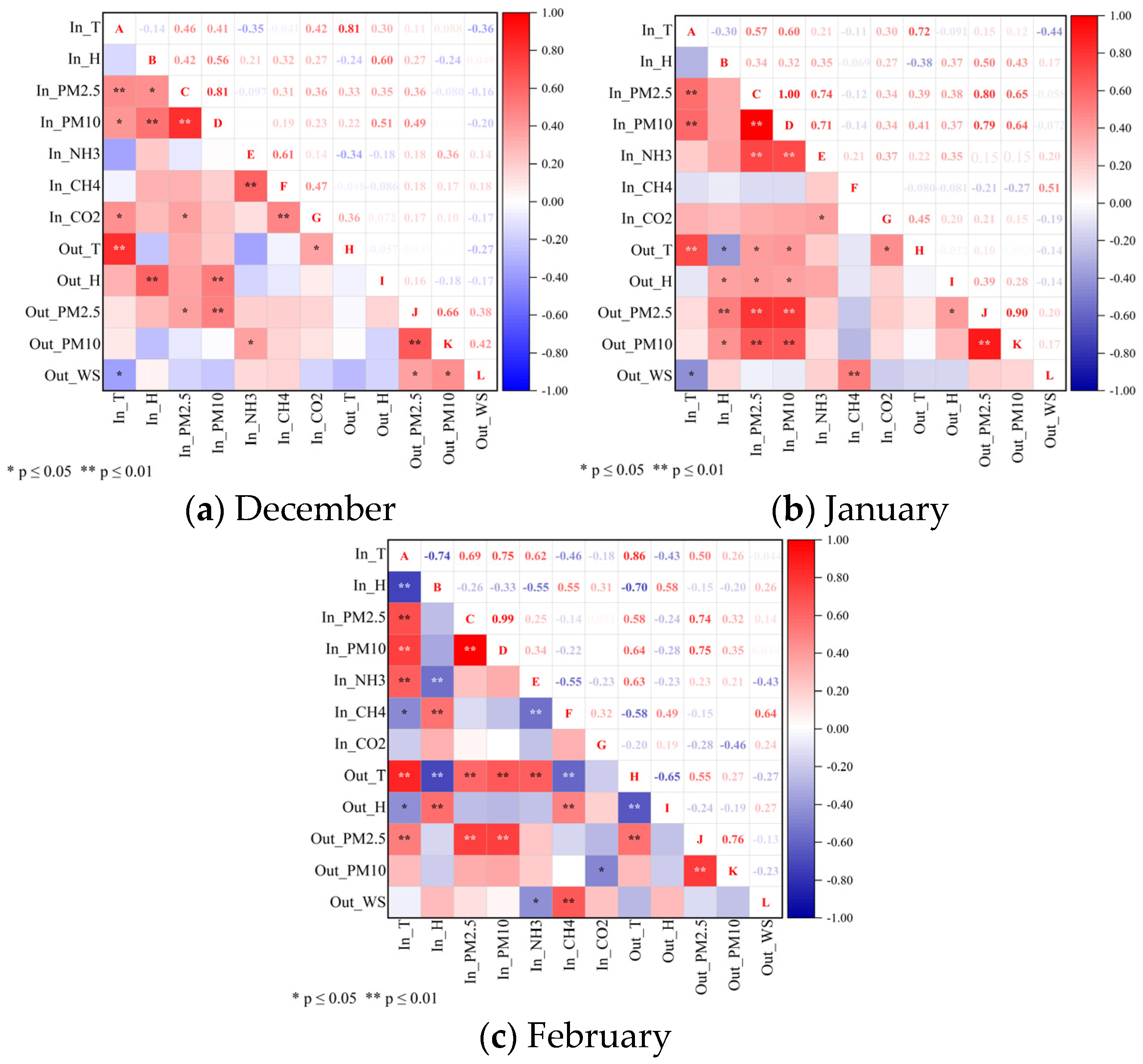
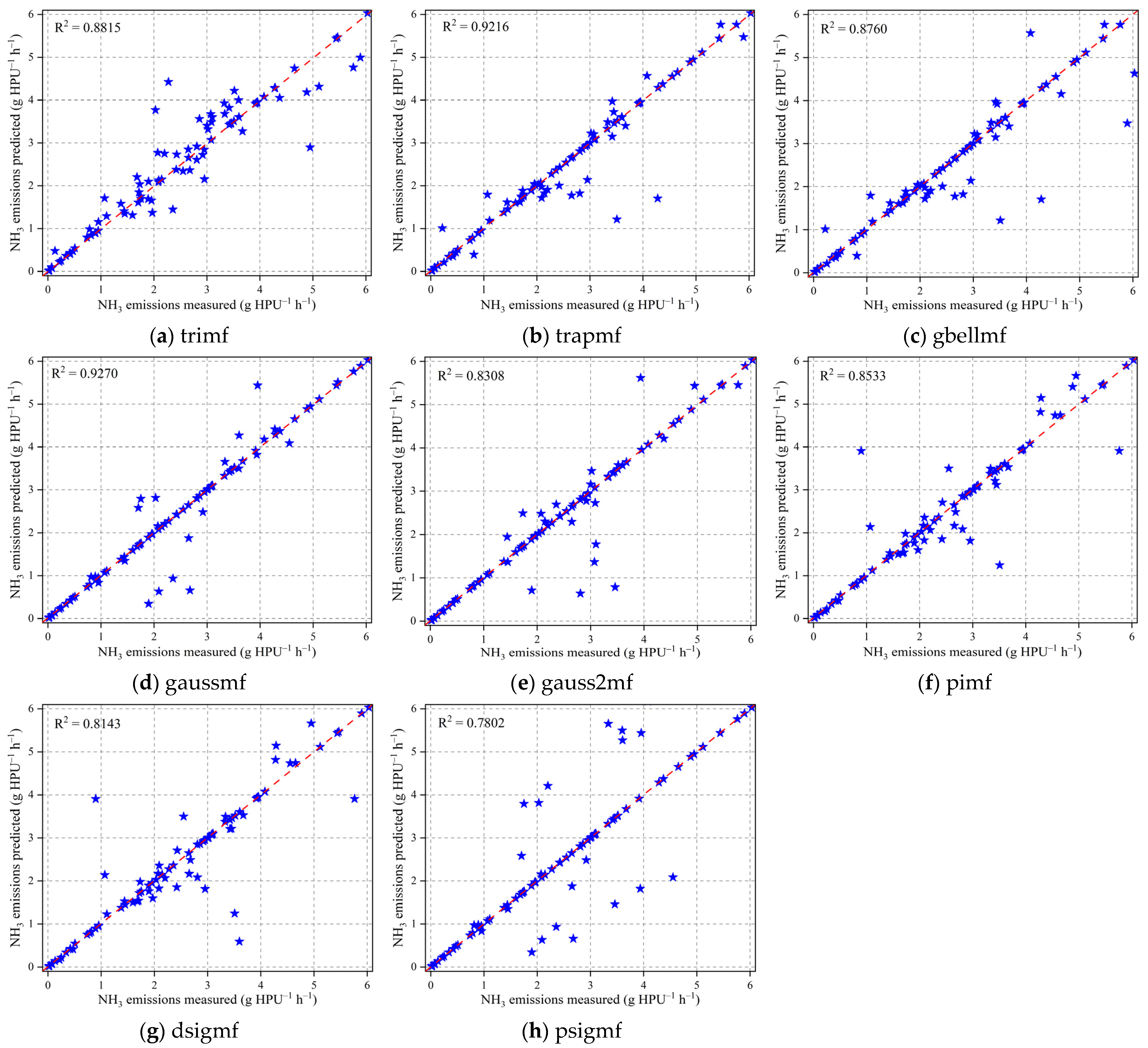

| Variables | Min | Max | Mean | Median | Standard Deviation | Coefficient of Variation |
|---|---|---|---|---|---|---|
| Inside temperature (°C) | −11.58 | 13.01 | −0.23 | −0.29 | 3.44 | −14.98 |
| Inside humidity (% RH) | 27.9 | 99.27 | 83.40 | 89.27 | 14.64 | 0.18 |
| Inside PM2.5 (μg m−3) | 0.03 | 251.37 | 28.09 | 17.14 | 31.57 | 1.12 |
| Inside PM10 (μg m−3) | 0.07 | 340.62 | 37.06 | 26.64 | 36.34 | 0.98 |
| Inside NH3 (mg m−3) | 0 | 7.50 | 1.40 | 1.08 | 1.43 | 1.02 |
| Inside CH4 (mg m−3) | 4.56 | 13.23 | 10.19 | 9.99 | 1.19 | 0.12 |
| Inside CO2 (mg m−3) | 860.76 | 3602.90 | 2045.56 | 2068.8 | 615.60 | 0.30 |
| Outside temperature (°C) | −32.24 | 11.42 | −12.71 | −12.85 | 7.01 | −0.55 |
| Outside humidity (% RH) | 11.69 | 87.73 | 54.48 | 55.81 | 17.60 | 0.32 |
| Outside PM2.5 (μg m−3) | 0 | 152.33 | 4.75 | 0.08 | 10.69 | 2.25 |
| Outside PM10 (μg m−3) | 4 | 206.17 | 13.36 | 10.00 | 12.28 | 0.92 |
| Outside wind speed (m s−1) | 0 | 6.78 | 1.42 | 1.08 | 1.01 | 0.71 |
| Ventilation rate (m3 HPU−1 h−1) | 0 | 28,663.90 | 1949.96 | 1692.42 | 2091.95 | 1.07 |
| Project | Membership Functions | |||||||
|---|---|---|---|---|---|---|---|---|
| trimf | trapmf | gbellmf | gaussmf | gasuss2mf | pimf | dsigmf | psigmf | |
| NRMSE | 0.2174 | 0.1769 | 0.2223 | 0.1751 | 0.1751 | 0.2529 | 0.2896 | 0.3432 |
| MAPE (%) | 15.0429 | 11.0205 | 11.9468 | 7.1837 | 9.0967 | 11.6995 | 12.8498 | 14.0698 |
| R2 | 0.8815 | 0.9216 | 0.8760 | 0.9270 | 0.8308 | 0.8533 | 0.8143 | 0.7802 |
| Project | Membership Functions | |||||||
|---|---|---|---|---|---|---|---|---|
| trimf | trapmf | gbellmf | gaussmf | gasuss2mf | pimf | dsigmf | psigmf | |
| RMSE | 0.1019 | 0.0899 | 0.1255 | 0.1007 | 0.1007 | 0.1498 | 0.1263 | 0.1827 |
| MAPE (%) | 5.9865 | 3.9890 | 5.1779 | 4.4717 | 5.5850 | 6.0673 | 6.4760 | 8.9524 |
| R2 | 0.8879 | 0.8977 | 0.7864 | 0.8600 | 0.8047 | 0.7465 | 0.7870 | 0.6099 |
| Project | R2 | NRMSE | MAPE | |
|---|---|---|---|---|
| NH3 emissions | Optimal ANFIS model | 0.9270 | 0.1751 | 7.1837 |
| MLP | 0.8706 | 0.2244 | 26.4081 | |
| RBF | 0.8314 | 0.2566 | 22.6251 | |
| CH4 emissions | Optimal ANFIS model | 0.8977 | 0.0899 | 3.9890 |
| MLP | 0.8364 | 0.1126 | 8.8648 | |
| RBF | 0.8158 | 0.1192 | 9.1891 | |
Disclaimer/Publisher’s Note: The statements, opinions and data contained in all publications are solely those of the individual author(s) and contributor(s) and not of MDPI and/or the editor(s). MDPI and/or the editor(s) disclaim responsibility for any injury to people or property resulting from any ideas, methods, instructions or products referred to in the content. |
© 2025 by the authors. Licensee MDPI, Basel, Switzerland. This article is an open access article distributed under the terms and conditions of the Creative Commons Attribution (CC BY) license (https://creativecommons.org/licenses/by/4.0/).
Share and Cite
Liu, H.; Wang, X.; Tana; Xie, T.; Hurichabilige; Zhen, Q.; Li, W. Predicting Winter Ammonia and Methane Emissions from a Naturally Ventilated Dairy Barn in a Cold Region Using an Adaptive Neural Fuzzy Inference System. Agriculture 2025, 15, 1560. https://doi.org/10.3390/agriculture15141560
Liu H, Wang X, Tana, Xie T, Hurichabilige, Zhen Q, Li W. Predicting Winter Ammonia and Methane Emissions from a Naturally Ventilated Dairy Barn in a Cold Region Using an Adaptive Neural Fuzzy Inference System. Agriculture. 2025; 15(14):1560. https://doi.org/10.3390/agriculture15141560
Chicago/Turabian StyleLiu, Hualong, Xin Wang, Tana, Tiezhu Xie, Hurichabilige, Qi Zhen, and Wensheng Li. 2025. "Predicting Winter Ammonia and Methane Emissions from a Naturally Ventilated Dairy Barn in a Cold Region Using an Adaptive Neural Fuzzy Inference System" Agriculture 15, no. 14: 1560. https://doi.org/10.3390/agriculture15141560
APA StyleLiu, H., Wang, X., Tana, Xie, T., Hurichabilige, Zhen, Q., & Li, W. (2025). Predicting Winter Ammonia and Methane Emissions from a Naturally Ventilated Dairy Barn in a Cold Region Using an Adaptive Neural Fuzzy Inference System. Agriculture, 15(14), 1560. https://doi.org/10.3390/agriculture15141560








